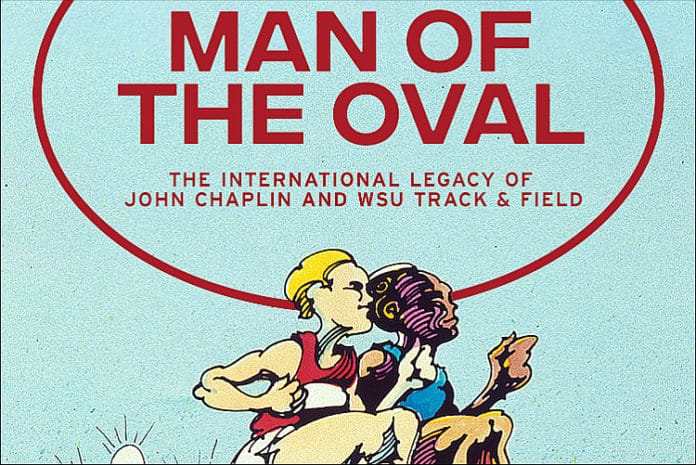★ The Sports Examiner: Chronicling the key competitive, economic and political forces shaping elite sport and the Olympic Movement.★
★ To get The Sports Examiner by e-mail: sign up here! ★
“One of the coaches that read an early version of this book said you need to explain how you handled us at a meet when we came screaming to you with a protest or a question on procedure, etc.
“So here goes.
“When a coach, the athlete’s manager, or anyone else the athlete has sent, came in to protest, I would first give them my speech: ‘Coach let’s understand the ground rules. I am a cynical, sarcastic, S.O.B. Now that we both know what I am, you don’t have to waste my mine and your time by you telling me that. Then I would say, what is your problem and let’s see if we can fix it.
“Then if things were got to the place where the coach is feeling sorry for him or herself and start talking about fairness, etc., I’d say, Coach ‘if you want love, get a puppy. The puppy will love you when you wife or husband or whoever may not.’ Then I would say, ‘I am here to make sure that the rules are followed, and my decision will be based on the facts, not on emotions.’ If this individual does get or does not like the answer or ruling, I’d suggest the coach or agent or whoever ‘go out and tell your wife or husband or your assistant coaches that I am a S.O.B., but do it quietly so as to not get on YouTube.’”
That’s former Washington State cross country and track & field coach John Chaplin, now 85, exactly as so many people know him. Direct, opinionated and relentlessly expert. In Man of the Oval, a new, 296-page hardcover biography, also available as an e-Book, author Bruce Blizard – himself a former track coach and teacher in eastern Washington – offers a dramatic look at Chaplin’s brilliant career as a coach, educator and track & field administrator.
All the controversies, all the abruptness and the heartwarming stories of how Chaplin supported his – and other – athletes are included. And best of all, mostly in Chaplin’s own words:
“‘If you don’t understand me, the rest is irrelevant,’ Chaplin said. ‘I am not complicated. If I say I will do something, I will do it. If I say I won’t, I won’t. But I’m not closed to reevaluating anything. If you say you can’t do something, I will listen, but if you say I won’t do something, it’s game over. I am a lot of things, but insecure is not one of them.’”
Chaplin’s story is hardly a straight line to success. Stocky, with a powerful, clipped cadence and known for coaching distance runners like Kenyan Henry Rono to greatness, Chaplin was a sprinter. He grew up in Los Angeles and attended Wilson High School, then Pasadena City College and graduated from Washington State with bests of 9.5 for 100 yards, 10.2 for 100 meters, 20.8 for 220 yards and 46.8 for 440 yards. Pretty good for 1963!
He had worked for a time at the now-defunct Los Angeles Examiner newspaper, but eventually ended up back in eastern Washington as the track coach and World Problems teacher at Wapato High School. After three successful years there – 50-4-1 in dual meets – he was thinking seriously of going to law school, but was hired instead as an assistant coach at Oregon State. For those who know him, can you imagine Chaplin as a career litigator in a courtroom? Generations of judges are grateful he stayed with sports.
His old Washington State coach, John Mooberry, hired Chaplin to be the head cross country coach in 1968 and Chaplin took over after Mooberry’s retirement, coaching the Cougars’ track & field team from 1974-94. He had a dual-meet record of 202-15, won the 1977 NCAA men’s Indoor team title and finished second four times at the NCAA Championships, in 1984-85-86-91. His WSU cross country teams were NCAA runner-ups in 1971 and 1975.
Chaplin reached star status thanks to the exploits of his athletes, most notably Rono, who set four world records in 81 days in the spring and summer of 1978, in the 5,000 m, Steeplechase, 10,000 m and 3,000 m. But his Kenyan connection didn’t start there:
“‘In the summer of 1971, I am sitting in my office playing with my paper airplanes with nothing to do,’ Chaplin explained, ‘when two Black gentlemen come into the office. One is a graduate student, and the other is a professor in political science at a small university in the Seattle area. Both gentlemen were from Kenya, and one was Dr. Jonathon Ngeno, who later became the Speaker of the House in Kenya and an advisor to the Kenyan president, Daniel Toroitich Arap Moi.’
“Dr. Ngeno told Chaplin he had a younger brother, also named John Ngeno, and his younger brother had a friend, also named John Ngeno. At first, Chaplin was confused, but he became intrigued when Dr. Ngeno told him a little more about the two young Kenyans. John Ngeno no. 1 [later known as Kip] was a 14.2 high hurdler, and John Ngeno no. 2 was a 13:45 5,000-meter runner. And both John Ngenos were looking for a place to go to school in the US. …
“Chaplin discovered later that Dr. Ngeno had also contacted coaches at the University of Illinois, Cal, Washington, ‘and several others,’ he said, ‘but none of them followed up, so I get to look good for a great recruiting job when in truth I did not do much.’”
The distance-running John Ngeno became a star, winning 13 individual NCAA cross country and track titles from 1972-76. That established WSU as a destination for Kenyans; 1968 and 1972 Olympic icon Kip Keino suggested future two-time NCAA 5,000 m champ Joshua Kimeto. Munich ‘72 Olympic Steeple silver medalist Ben Jipcho introduced future 10,000 m world-record holder Samson Kimombwa. Kimeto and Ngeno called Chaplin from the 1976 Olympic Games in Montreal and turned Chaplin on to Rono, a steepler, who didn’t get to run due to the African boycott of the Games.
When Chaplin saw what Rono could do in workouts against stars Kimeto and Kimombwa:
“I brought Henry into my office and said, ‘Henry, I think that you could be the first man in history to hold the world record in all three Olympic distance races.’”
Rono wasn’t sure, but agreed to try. Chaplin continued, “But I told him first, we would have to look at the schedule … and then work out a program where he’d run a race in preparation, and in the next race, we correct any problems. And then, ‘You run for the record.'”
And that’s what happened. But there were controversies along the way, such as in mid-April of 1978:
“The story goes that Chaplin had Rono back off in the final 600 meters of the 3,000-meter steeplechase in a dual meet against the University of Oregon at venerable Hayward Field in Eugene. Chaplin has since been accused of wanting to deny the knowledgeable and enthusiastic fans in Eugene the satisfaction of seeing the world record set in their stadium. But the truth is either more complicated or more interesting, depending on your point of view. With a lap and a half left in the race, Rono was running close to the steeplechase world record of 8:08.02, held at the time by Anders Garderud of Sweden, but Chaplin believed the water jump pit at Hayward Field was too shallow.
“‘I didn’t want Rono to set the record there and then have it disallowed later,’ he explained, ‘so, I yelled at Henry to slow down.’ Rono did as he was instructed. He still finished in 8:14.75, a new collegiate record, and the fastest time ever on American soil at the time.”
But then Rono was unleashed, setting world marks of 13:08.4 for 5,000 m in a dual meet at California on 8 April, then 8:05.4 for the Steeple at the Northwest Relays in Seattle on 13 May, 27:22.5 for 10,000 m in Vienna, Austria, on 11 June and 7:32.1 for 3,000 m at the Bislett Games in Oslo, Norway, on 27 June.
Chaplin also noted the cultural differences in dealing with athletes from other countries, including this oft-retold classic:
“’An example comes to mind with John Ngeno,’ he said. ‘It was the second time that Ngeno competed in Modesto at three miles. John wins, and they give him another TV set. That night at the motel, I keep getting calls from the front desk. So finally, at 4:00 a.m., I go down to the office, and I pass a calf tied to a palm tree. The manager says, ‘One of your athletes brought this calf over to the motel and tied it to the palm tree. What are you going to do about it?’ So, a little later, as we are getting ready to go to the airport, I ask, ‘Do any of you know about that calf tied to the tree?’ John says, ‘Yes, Coach, I traded my second TV – one only needs one TV – to a farmer for the calf, and I want to take it back to Pullman.’
“I explain that United Airlines does not have the ability to carry the calf back to Pullman, nor did we have any other method to so do. So, I call Tom Moore, the meet director, and say, ‘Can you pick up this calf that Ngeno traded to a farmer for the TV you gave him for winning the three mile and send it to WSU?’ Tom laughs and says, ‘Yes.’ After talking to Ngeno, I realize that he figured if he could get the calf to Pullman and find a farmer to buy it, he can then take the money back to Kenya and buy himself a few cows with the cash. Rational behavior in a society in which cows are wealth. And just another day in the life of Cougar Track & Field.”
Chaplin finally left coaching in 1994, taking a position with the WSU Provost’s Office. “I stayed with the Provost’s Office and taught classes off and on from the summer of 1994 to the spring of 2002, when I turned 65 and retired from WSU. …
“‘If I had one regret about how the program was treated during my tenure of twenty-seven years at WSU,’ Chaplin said, ‘it was that in all that time, not one athletic director ever came into the track office and asked, ‘How can WSU and I help your program?’ In fact, I don’t remember more than a few times that a WSU AD was ever at a dual meet at Mooberry [Track & Field Complex].’”
But Chaplin did not leave the sport by a long shot. He was deeply involved in the U.S. National Governing Body for track & field, today known as USA Track & Field. He was the head referee for the 1996 Olympic track & field competition in Atlanta and the U.S. head men’s coach for the 2000 Sydney Games. He was the Chair of the USATF International Competition Committee for 24 years and the head of the Men’s Track & Field Committee. He is still sought out for his advice on technical issues and is a fixture at the U.S. nationals.
All of this masks the significant effort Chaplin made to ensure his athletes graduated as well as competed. Many less-famous athletes whose track & field careers were immeasurably helped by Chaplin, also testified in the book on his emphasis on academics, getting a degree and getting a good job.
Long jumper Gerald Edwards’s comments were typical: “He said, ‘Gerald, If I wasn’t on your ass all the time, that means I don’t give a damn. I’m on your ass because I do give a damn.'”
High hurdler Dominique Arnold, the 1996 NCAA champion, came from Compton, California and later set the American Record at 12.90. He said of Chaplin:
“’I came from gang-infested territory,’ Arnold said. ‘And seeing this white guy caring for me was different. We didn’t grow up with white figures caring for you. But he showed me something different. I’d do anything for Chappy. He was everything I wanted in a father that I didn’t have growing up.’”
There’s a lot more in the book, including excellent detail on Chaplin’s coaching and racing methods, his use of surges to break opponents, changing an athlete’s belief system in himself and the balance between aerobic and anaerobic workouts. And all the statistics you could want on the WSU program in a lengthy appendix.
Blizard includes heartwarming testimonials to Chaplin’s support for women’s track & field and the advancement of women in coaching and administration in the sport.
For anyone who saw Chaplin’s amazing teams – who earned 218 NCAA All-American certificates in cross country, indoor and outdoor track – and molding cohesive squads out of Americans, Kenyans, Australians, Chinese, Ivory Coasters, New Zealanders and others, Man of the Oval combines Chaplin’s play-by-play, a coaching classroom and a love letter from his athletes, who helped create an unforgettable character who has, and continues, to shape American track & field.
Rich Perelman
Editor
You can receive our exclusive TSX Report by e-mail by clicking here. You can also refer a friend by clicking here, and can donate here to keep this site going.
For our updated, 651-event International Sports Calendar (no. 2) for 2023 and beyond, by date and by sport, click here!

























